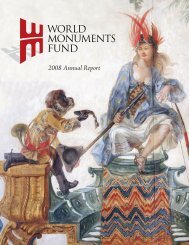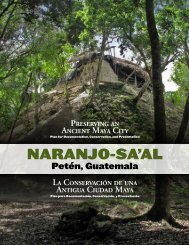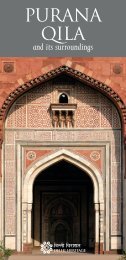Summary of the Proceedings and Papers Presented at - World ...
Summary of the Proceedings and Papers Presented at - World ...
Summary of the Proceedings and Papers Presented at - World ...
Create successful ePaper yourself
Turn your PDF publications into a flip-book with our unique Google optimized e-Paper software.
The project<br />
The main areas to be tackled by <strong>the</strong> project are as follows:<br />
n Removal <strong>of</strong> <strong>the</strong> existing ro<strong>of</strong> over room 6;<br />
n Construction <strong>of</strong> new ro<strong>of</strong>s, for which we have developed<br />
a hypo<strong>the</strong>tical maximum <strong>and</strong> minimum proposal;<br />
n Excav<strong>at</strong>ion <strong>and</strong> redesign <strong>of</strong> <strong>the</strong> gardens;<br />
n Replacement <strong>of</strong> <strong>the</strong> skylights on <strong>the</strong> terrace <strong>of</strong> <strong>the</strong> b<strong>at</strong>hs;<br />
n Restor<strong>at</strong>ion <strong>of</strong> <strong>the</strong> shore-level substructures <strong>of</strong> <strong>the</strong><br />
House <strong>of</strong> <strong>the</strong> Telephus Relief;<br />
n Construction <strong>of</strong> a vertical link between <strong>the</strong> two levels <strong>of</strong><br />
<strong>the</strong> House <strong>of</strong> <strong>the</strong> Telephus Relief;<br />
n Identific<strong>at</strong>ion <strong>of</strong> advantages <strong>and</strong> disadvantages <strong>of</strong><br />
reconstructing <strong>the</strong> facade <strong>of</strong> <strong>the</strong> House <strong>of</strong> Granianus;<br />
n Work required to complete <strong>the</strong> excav<strong>at</strong>ion <strong>and</strong> study <strong>of</strong><br />
<strong>the</strong> insula.<br />
The project must be guided above all by a duty to memory:<br />
a duty to memory for <strong>the</strong> enormous archaeological<br />
importance <strong>and</strong> physical presence ñ Roman, Bourbon, or<br />
ìMaiurianî—<strong>of</strong> wh<strong>at</strong> has reached us. Too much has already<br />
been lost, <strong>and</strong> wh<strong>at</strong> survives must be protected to <strong>the</strong> best<br />
<strong>of</strong> our ability by developing targeted conserv<strong>at</strong>ion str<strong>at</strong>egies<br />
<strong>and</strong> making architectural choices which take account <strong>of</strong> this<br />
central duty.<br />
Current conditions, <strong>the</strong> result <strong>of</strong> excav<strong>at</strong>ion <strong>and</strong> restor<strong>at</strong>ion<br />
work from <strong>the</strong> discovery <strong>of</strong> Herculaneum until today,<br />
now represent a point <strong>of</strong> no return: any intervention on <strong>the</strong><br />
site must take into consider<strong>at</strong>ion not only <strong>the</strong> remains <strong>of</strong> <strong>the</strong><br />
Roman city, but also <strong>the</strong> town which has developed from<br />
1738 until today. As already observed in <strong>the</strong> preliminary report,<br />
<strong>the</strong> reconstructions <strong>and</strong> additions made in <strong>the</strong> past are<br />
now <strong>the</strong>mselves part <strong>of</strong> history, <strong>and</strong> form an integral part <strong>of</strong> a<br />
single architectural entity, where restor<strong>at</strong>ions have become<br />
part <strong>and</strong> parcel <strong>of</strong> <strong>the</strong> original.<br />
The question posed in our Osservazioni (Observ<strong>at</strong>ions)<br />
remains pertinent: “wh<strong>at</strong> should we do now? Should we continue<br />
with rebuilding work, or change direction entirely <strong>and</strong><br />
avoid any fur<strong>the</strong>r rebuilding? Should we continue to rebuild<br />
without excessive concern, trying where possible to give<br />
some idea <strong>of</strong> <strong>the</strong> ancient structures, recre<strong>at</strong>ing <strong>the</strong>ir original<br />
spaces, <strong>and</strong> <strong>the</strong> layout <strong>of</strong> individual rooms <strong>and</strong> <strong>the</strong> rel<strong>at</strong>ionship<br />
between interiors <strong>and</strong> exteriors? Or should we cleanse<br />
<strong>the</strong> original structures <strong>of</strong> useless additions, <strong>and</strong> limit rebuilding<br />
to <strong>the</strong> absolute minimum, preferring to remove decor<strong>at</strong>ive<br />
elements ra<strong>the</strong>r than rebuild a lost room to cre<strong>at</strong>e <strong>the</strong><br />
conditions for <strong>the</strong>ir survival?”<br />
These questions can find a well-considered answer only<br />
in <strong>the</strong> <strong>at</strong>tentive observ<strong>at</strong>ion <strong>of</strong> <strong>the</strong> insula itself, avoiding<br />
<strong>the</strong>oretical proclam<strong>at</strong>ions <strong>and</strong> <strong>the</strong> adoption <strong>of</strong> academic<br />
positions. We should continue to rebuild where necessary<br />
to cover rooms which can only be conserved if closed, or<br />
where this would significantly improve <strong>the</strong> underst<strong>and</strong>ing <strong>of</strong><br />
spaces. We should avoid rebuilding work dict<strong>at</strong>ed merely by<br />
<strong>the</strong> desire to give concrete shape to a hypo<strong>the</strong>tical reconstruction,<br />
with little impact on <strong>the</strong> conserv<strong>at</strong>ion <strong>of</strong> <strong>the</strong> structures<br />
<strong>and</strong> involving an excessive addition <strong>of</strong> new m<strong>at</strong>erials.<br />
As such, <strong>the</strong> conserv<strong>at</strong>ion project should not be considered<br />
simply a m<strong>at</strong>erial expression <strong>of</strong> excav<strong>at</strong>ion d<strong>at</strong>a:<br />
rebuilding wh<strong>at</strong> certainly existed, stopping where we have<br />
doubts. We may decide not to rebuild an element th<strong>at</strong> definitely<br />
existed, thus fixing archaeological evidence in threedimensions,<br />
or we may choose to reconstruct hypo<strong>the</strong>tical<br />
structures, needed to stop decay or to recre<strong>at</strong>e a more coherent<br />
<strong>and</strong> balanced architectural image.<br />
The consider<strong>at</strong>ions outlined above obviously imply a<br />
certain degree <strong>of</strong> arbitrariness (<strong>of</strong> <strong>the</strong> type inherent in any<br />
musical interpret<strong>at</strong>ion, however faithful to <strong>the</strong> score). Any<br />
pretence to neutrality, avoiding interference with <strong>the</strong> architectural<br />
history <strong>of</strong> <strong>the</strong> site or interpret<strong>at</strong>ion <strong>of</strong> it, would be<br />
mere hypocrisy. The intellectual honesty which must lie behind<br />
any task <strong>of</strong> this importance requires us to recognize<br />
<strong>the</strong> need for interventions which will inevitably confer a new<br />
appearance on <strong>the</strong> monumental complex, <strong>and</strong> thus for considered<br />
<strong>and</strong> responsible design choices.<br />
As we mentioned earlier, <strong>the</strong> Insula Orientalis I suffers<br />
from highly visible decay, due to <strong>the</strong> exposure <strong>of</strong> m<strong>at</strong>erials<br />
designed for interiors to <strong>at</strong>mospheric agents. On <strong>the</strong> one<br />
h<strong>and</strong>, it is obviously impossible to reconstruct <strong>the</strong> ancient<br />
ro<strong>of</strong>s in <strong>the</strong>ir entirety, cre<strong>at</strong>ing a ro<strong>of</strong> covering <strong>the</strong> entire<br />
excav<strong>at</strong>ion area, without den<strong>at</strong>uring <strong>the</strong> site. On <strong>the</strong> o<strong>the</strong>r<br />
h<strong>and</strong>, we cannot continue to ignore <strong>the</strong> fact th<strong>at</strong> large quantities<br />
<strong>of</strong> original m<strong>at</strong>erial are lost each year in uncovered areas.<br />
It would be truly irresponsible not to learn from wh<strong>at</strong> we<br />
have failed to conserve in <strong>the</strong> absence <strong>of</strong> ro<strong>of</strong>s.<br />
It is thus clear th<strong>at</strong> must proceed with gre<strong>at</strong>er determin<strong>at</strong>ion<br />
to reconstruct ro<strong>of</strong>s in those areas where <strong>the</strong> importance<br />
<strong>of</strong> <strong>the</strong> m<strong>at</strong>erials bene<strong>at</strong>h makes this necessary. The<br />
idea <strong>of</strong> cre<strong>at</strong>ing ro<strong>of</strong>s raised above <strong>the</strong> tops <strong>of</strong> <strong>the</strong> walls does<br />
not seem appropri<strong>at</strong>e, both for reasons <strong>of</strong> effective conserv<strong>at</strong>ion<br />
(horizontal rain, pigeons), <strong>and</strong> on aes<strong>the</strong>tic grounds<br />
(<strong>the</strong> current ro<strong>of</strong> over room no. 6 should suffice to discourage<br />
<strong>at</strong>tempts <strong>of</strong> this sort). The addition <strong>of</strong> obviously modern<br />
ro<strong>of</strong>s is not in keeping with <strong>the</strong> image which Herculaneum<br />
has acquired, <strong>and</strong> would end up conferring a ìmuseum-likeî<br />
appearance on a site in which urban space predomin<strong>at</strong>es.<br />
From a museological point <strong>of</strong> view it is difficult to change<br />
direction from past rebuilding work, which cre<strong>at</strong>ed a realistic<br />
architectural appearance. However, from <strong>the</strong> point <strong>of</strong> view<br />
<strong>of</strong> conserv<strong>at</strong>ion we are forced to do more: we must go beyond<br />
Maiuri <strong>and</strong> venture into <strong>the</strong> realm <strong>of</strong> hypo<strong>the</strong>sis, even<br />
in <strong>the</strong> absence <strong>of</strong> archaeological evidence.<br />
The best solution is thus to continue to rebuild ad identicum,<br />
using fl<strong>at</strong> <strong>and</strong> curved ro<strong>of</strong> tiles resting on rafters <strong>of</strong> different<br />
sizes, avoiding technological solutions th<strong>at</strong> have little<br />
to do with <strong>the</strong> genius loci which has gradually taken possession<br />
<strong>of</strong> <strong>the</strong> site. Only where <strong>the</strong>re is enormous archaeological<br />
uncertainty will it be worth designing ro<strong>of</strong>s th<strong>at</strong> conform<br />
to a hypo<strong>the</strong>tical reconstruction, but using different m<strong>at</strong>erials<br />
which should never<strong>the</strong>less be comp<strong>at</strong>ible with <strong>the</strong> ancient<br />
formal universe (copper, lead etc.).<br />
On <strong>the</strong> o<strong>the</strong>r h<strong>and</strong>, we should avoid cre<strong>at</strong>ing a hodgepodge<br />
appearance which is nei<strong>the</strong>r declaredly modern (e.g.<br />
a lamin<strong>at</strong>ed wood ro<strong>of</strong>) nor in accur<strong>at</strong>e “ancient style” (e.g.<br />
a ro<strong>of</strong> in chestnut wood using ancient building techniques),<br />
resulting from <strong>the</strong> use <strong>of</strong> second-r<strong>at</strong>e m<strong>at</strong>erials such as pinewood<br />
beams tinted in imit<strong>at</strong>ion <strong>of</strong> more expensive woods, or
















